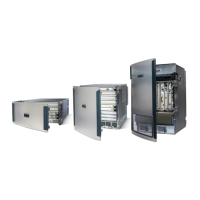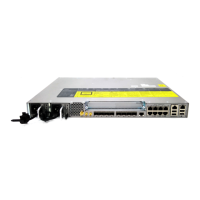23
Cisco 12000 Series Router Memory Replacement Instructions
78-4338-16
Removing and Installing Line Card Memory
If the router fails to restart properly after several attempts, access Cisco.com or contact a Cisco customer
service representative for assistance. Before you call, make note of any error messages, unusual LED
states, or any other indications that might help solve the problem.
Removing and Installing Line Card Memory
Cisco 12000 Series Router line cards use the following types of field serviceable memory:
• Route memory (DRAM)—Each Cisco 12000 Series Router line card includes DRAM DIMM or
SODIMM sockets. (See Figure 3, Figure 4, Figure 5, and Figure 6.) The DRAM is used by the line
card’s processor. (See Table 4 for all route memory options.)
• Packet memory (SDRAM)—Each Cisco 12000 Series Router line card includes SDRAM DIMM or
SODIMM sockets. (See Figure 3, Figure 4, Figure 5, and Figure 6.) The SDRAM is used by the line
card’s transmit (TX) and receive (RX) buffers. See Table 5 for the default packet memory
configuration of each line card.
Maximum configurations also depend on the line card type. Some line cards support a maximum
configuration of 128 MB, while other line cards support a maximum configuration of 512 MB.
Caution Packet memory on ISE, Engine 4, and Engine 4+ line cards is not field serviceable. On ISE line cards,
the packet memory SODIMM modules look identical to the route memory SODIMMs; however, they
will not work in the packet memory sockets. Do not attempt to install route memory SODIMM modules
in packet memory sockets; this will cause the board to fail when you reboot the card.
Both route memory and packet memory can be replaced or upgraded in the field. See Table 4 on page 13
for the available DRAM DIMM options or Table 5 on page 14 for the available SDRAM DIMM options
that you can use for configuring memory. Observe the following guidelines:
• Line card route memory DRAM (Engine 0, 1, and 2)
–
Route memory DIMM0 socket must always be populated.
–
For certain memory configurations, the route memory DIMM1 socket can remain empty.
–
DRAM DIMMs must be 3.3V devices.
• Line card route memory DRAM (ISE, Engine 4, and Engine 4+)
–
ISE line cards—Use two 256-MB, 144-pin SODIMM memory modules. Route memory
DIMM0 socket must always be populated.
–
ATM ISE line cards—Can also use one or two 512-MB, 144-pin SODIMM memory modules
–
Engine 4 and Engine 4+ line cards—Use one 256-MB, 144-pin SODIMM memory module
• Line card transmit and receive packet memory SDRAM (Engine 0, 1, and 2)
–
All four DIMM sockets for SDRAM buffer memory must be populated.
–
Both DIMM sockets for a given buffer pair (either those for the transmit buffer or those for the
receive buffer) must be populated with SDRAM DIMMs of the same type and size.
–
Size of the SDRAM DIMMs in the transmit buffer need not match the size of the SDRAM
DIMMs in the receive buffer.
–
SDRAM DIMMs must be 3.3V devices.

